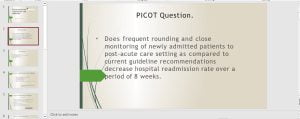COURSE
NR706 – Healthcare Informatics & Information Systems, Online DNP Program Faculty
Purpose
The purpose of this assignment is to critically evaluate a practice problem idea you identified. This assignment builds on the Week 4 assignment. Information used in the Week 4 assignment may be used as a basis for this assignment. The goal is to develop a deeper understanding of the identified practice problem idea, using two continuous quality improvement tools, specifically, a Failure Mode and Effects Analysis (FMEA) and an Ishikawa (fishbone) cause and effect diagram to analyze, improve, and mitigate related risks. This assignment will allow you to apply competencies through sequential development of workflow steps in relation to an identified practice problem idea and promotion of presentation skills. Assignment content supports professional formation, communication, and dissemination skills relevant to the DNP-prepared nurse.
Instructions
This assignment has four components:
- Identified practice problem idea in PICOT format
- Failure Mode and Effects Analysis
- Ishikawa (Fishbone) cause and effect diagram
- Professional PowerPoint with speaker notes at the bottom of each slide to disseminate information
Follow these guidelines when completing each component of the assignment. Contact your course faculty if you have questions.
- Consider the identified practice problem idea used in the Week 4 translation science project including PICOT, background, and significance. Incorporate course faculty feedback from the Week 4 assignment.
- Review the examples of the failure mode and effects analysis and fishbone diagram in the Week 4 Explore section of the course called Evidence-Based Practice: Improving Outcomes.
- Download the required documents inserted in the guidelines:
- Link (PPT): PowerPoint TemplateLinks to an external site.
- Link (Word doc): Failure Mode and Effects Analysis TemplateLinks to an external site.
- Link (Word doc): Ishikawa Fishbone Template ALinks to an external site. (Word 2016 or higher)
- Link (Word doc): Ishikawa Fishbone Template BLinks to an external site. (older version of Word)
- Complete the failure mode and effects analysis and then the Ishikawa fishbone diagram. The Ishikawa fishbone diagram requires Word 2016 to download. If you do not have the Word 2016 version, you may update your current version of Word (click on the following link for instructions: Office 365Links to an external site.) or use the alternative version provided or create your own fishbone diagram as long as you are addressing the five areas:
- People
- Environment
- Materials
- Methods
- Equipment
- Create the PowerPoint Presentation.
The assignment should include the following components. Use the templates provided for the assignment.
- Introduction (1 slide)
- Title of Practice Problem Analysis Presentation
- Student Name
- Assignment Title
- Course Faculty Name
- Practice Problem Identification (1-3 slides)
- State identified practice problem as a PICOT question in question format.
- Identify all PICOT components.
- Describe the background and significance of the identified practice problem idea (cited).
- Develop inclusion criteria for the population of interest.
- Develop exclusion criteria for the population of interest.
- Failure Mode and Effects Analysis (1-2 slides)
- Identify three steps in the identified practice problem idea process with potential breakdown or process gaps.
- Identify at least one potential error (failure mode) for each of the three process steps.
- Identify at least one possible cause of failure (failure cause) for each of the three process steps.
- Identify at least one adverse consequence (failure effect) for each of the three process steps.
- Using a scale 1-10, rate likelihood of occurrence of failure for each process step.
- Using a scale 1-10, rate likelihood of detection of failure for each process step.
- Using a scale 1-10, rate likelihood of severity of harm if failure occurs for each process step.
- Calculate the Risk Profile Number (Multiply likelihood of occurrence X likelihood of detection X likelihood of severity or harm).
- Summarize FMEA analysis.
Note: The following article has scoring guidelines for FMEA ratings which may be helpful.
Warnick, R. E., Lusk, A. R., Thaman, J. J., Levick, E. H., & Seitz, A. D. (2020). Failure mode and effects analysis (FMEA) to enhance safety and efficiency of Gamma Knife Radiosurgery.Links to an external site. Journal of Radiosurgery and SBRT, 7, 115-125.
- Ishikawa (Fishbone) Cause and Effect Diagram (1-2 slides)
- Identify people involved in the identified practice problem idea.
- Identify the environment in which the identified practice problem idea occurs.
- Identify the materials used.
- Identify the methods used.
- Identify the equipment used.
- Summarize cause and effect analysis.
- Evidence-Based Intervention (1 -2 slides)
- Identify the evidence-based intervention for your identified practice problem idea (listed in PICOT).
- Identify barriers to overcome based upon what you learned from the FMEA and Fishbone Analyses.
- Discuss feasibility of the evidence-based intervention.
- Conclusion (1 slide)
- Summarize the purpose and findings of the analysis.
- Provide and justify the main conclusions.
- Draw inferences from the quality improvement analysis.
- References (1 slide)
- Include in-text citations used in the presentation.
- Provide complete matching references in correct APA format.
- Include minimum of four scholarly sources.
ANSWER

………please click the icon below to purchase full answer at $15